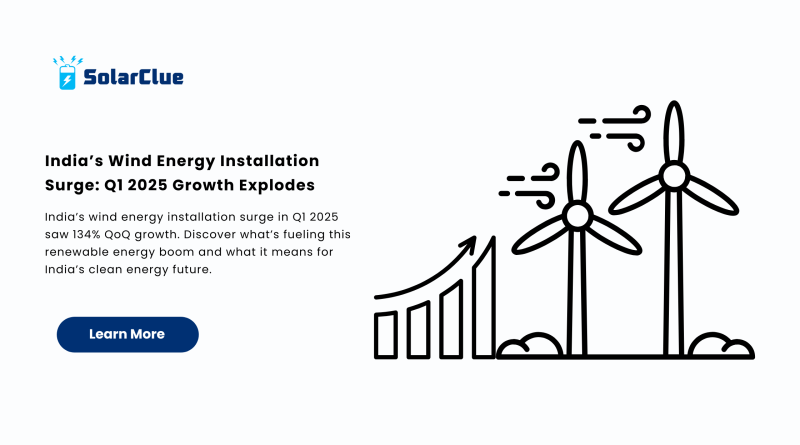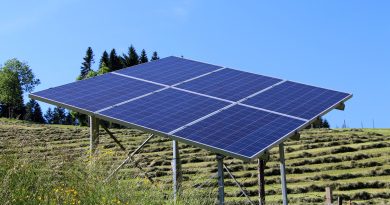India’s Wind Energy Installation Surge: Q1 2025 Growth Explodes
India is fast-tracking its shift to renewable energy, and the first quarter of 2025 marks a turning point. The country has witnessed an unprecedented wind energy installation surge, reflecting strong policy support and an aggressive push for clean energy. The renewable sector, especially wind energy, is surging forward with a mission to make India self-sufficient and sustainable. Let’s explore what fueled this boom, the key players, and what lies ahead.
Table of Contents
- 1 Record-Breaking Wind Energy Growth in Q1 2025
- 2 The Key Drivers of Growth
- 3 Leading States Powering the Surge
- 4 Who Made It Happen?
- 5 India’s Cumulative Wind Capacity Hits 50 GW
- 6 Wind-Solar Hybrids: The Future of Clean Power
- 7 State Policies Fueling the Expansion
- 8 The ISTS Waiver: A Ticking Clock
- 9 What to Expect Next
- 10 How Wind and Solar Work Together
- 11 Diverse Clean Sources Mean Better Outcomes
- 12 Corporate India’s Role in Wind Expansion
- 13 Investment Opportunities Abound
- 14 Barriers Still Exist
- 15 India’s Global Position in Renewables
- 16 What Can You Do?
- 17 Conclusion
- 18 FAQs
Record-Breaking Wind Energy Growth in Q1 2025
India added a staggering 1.8 GW of wind energy capacity in Q1 2025—a 134% quarter-over-quarter (QoQ) jump and 63% year-over-year (YoY) growth. This marks one of the most significant surges in the country’s renewable history. It’s a clear reflection that the country is not just aiming for sustainability; it’s racing toward it.
The Key Drivers of Growth
The biggest catalyst was the government’s 100% Inter-State Transmission System (ISTS) charges waiver, set to expire in June 2025. This prompted developers to speed up commissioning to benefit from reduced costs. In addition, long-term commitments like the wind-specific Renewable Purchase Obligations (RPOs) and annual onshore wind bidding targets of 10 GW (from 2023 to 2027) created a stable investment environment for wind energy installation.
Leading States Powering the Surge
Karnataka led with 620 MW of new capacity. Surprisingly, Madhya Pradesh, which had no additions in the previous quarter, installed 351 MW. Tamil Nadu followed closely with 331 MW. Together, these states reflect the decentralized growth of wind energy across the country. Other states collectively contributed an additional 573 MW, showing how nationwide momentum is picking up.
Who Made It Happen?
Large developers played a major role. JSW Renew Energy commissioned 210.5 MW as part of SECI’s 2500 MW ISTS Tranche-IX across Karnataka and Tamil Nadu. Sembcorp added 54.6 MW under Tranche-XI in Karnataka. These players are not just deploying infrastructure; they’re shaping India’s energy future.
India’s Cumulative Wind Capacity Hits 50 GW

By the end of March 2025, India’s total wind energy installation capacity reached 50 GW—a 3.9% increase from December 2024. Gujarat leads with 12.6 GW, followed by Tamil Nadu (11.7 GW) and Karnataka (7.3 GW). Maharashtra and Rajasthan hold 5.2 GW each, while Andhra Pradesh and Madhya Pradesh are not far behind.
Wind-Solar Hybrids: The Future of Clean Power
Hybrid systems are gaining traction, especially those integrating wind energy and solar power systems. These setups deliver consistent output across day and night, making them more efficient and grid-friendly. Firm and Dispatchable Renewable Energy (FDRE) projects are setting new benchmarks for reliability in the clean power space.
State Policies Fueling the Expansion
Telangana recently set a target of 2.5 GW under its Renewable Energy Policy. Andhra Pradesh aims for a staggering 35 GW by 2029. Rajasthan’s new Integrated Clean Energy Policy targets 25 GW of hybrid and wind capacity by 2030. These state-level moves reflect serious intent to dominate the renewable energy space.
The ISTS Waiver: A Ticking Clock
The ISTS waiver was a game-changer, and with its expiry date looming, developers rushed to commission projects. If the waiver isn’t extended beyond June 2025, a temporary slowdown could occur. However, policy adjustments and hybrid incentives may continue to drive momentum.
What to Expect Next
As Q2 2025 unfolds, experts anticipate even more installations, especially with aging turbines being repowered. The integration of wind with solar energy will unlock even more grid value. Investors are keen, and India is primed to deliver.
How Wind and Solar Work Together
Solar energy and wind energy complement each other beautifully. Solar peaks during the day; wind often delivers power at night. This synergy improves grid stability and reduces dependence on fossil fuels, especially when combined with battery storage and intelligent forecasting systems.
Diverse Clean Sources Mean Better Outcomes
By using a mix of renewable energy sources, India can stabilize its grid, lower emissions, and reduce fuel imports. It also improves energy access in remote areas. This diversity is not just smart—it’s essential.
Corporate India’s Role in Wind Expansion
Corporates are now major players in this space. Many are investing in captive solar power systems and wind plants to meet ESG and decarbonization targets. With SECI’s competitive auctions and state tenders, the private sector’s role is bigger than ever.
Investment Opportunities Abound
The wind energy market is now a hotbed for both domestic and international investors. With declining equipment costs, better technology, and government backing, the return on investment looks promising. From infrastructure funds to green bonds, the options are growing fast.
Barriers Still Exist
Despite the optimism, challenges remain. Land acquisition is slow, transmission bottlenecks are real, and regulatory clarity is sometimes lacking. Addressing these issues is crucial to ensure sustained growth.
India’s Global Position in Renewables
India is now among the top five global players in clean energy. With 50 GW of wind energy installation and surging solar energy capacity, India’s credibility in climate leadership is at an all-time high.
What Can You Do?
Whether you’re an individual homeowner or a business owner, there’s a lot you can do. Install solar power systems, advocate for clean policies, and educate others. Small changes lead to big impacts, and your choices today shape tomorrow’s planet.
Conclusion
India’s exceptional Q1 2025 performance is a major milestone in its clean energy journey. With bold policy moves, robust developer participation, and rising public awareness, the path ahead is exciting. The India’s Wind Energy Installation Surge is not just a statistic—it’s a signal of a cleaner, brighter, and more energy-secure future.
FAQs
1. Why did wind energy installations rise so sharply in Q1 2025?
Because of the expiring ISTS waiver and favorable government policies, developers were in a rush to commission projects.
2. What is the ISTS waiver and why is it important?
It removes inter-state transmission charges, making wind projects more cost-effective and attractive to developers.
3. Which states lead in wind energy capacity?
Gujarat, Tamil Nadu, Karnataka, Maharashtra, and Rajasthan top the list.
4. What is a wind-solar hybrid system?
A renewable setup combining wind energy and solar energy to provide more consistent power generation.
5. How can businesses contribute to renewable energy goals?
By investing in solar power systems, buying green energy, and aligning with national climate objectives.
Ready to join India’s clean energy revolution? Discover how you can make a difference with wind and solar energy. Explore green solutions at solarclue.com or dive deeper into insights on blog.solarclue.com. Let’s power the future—together! ⚡🌱




